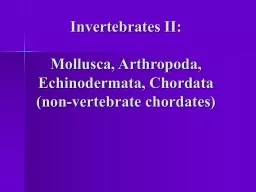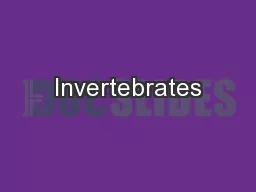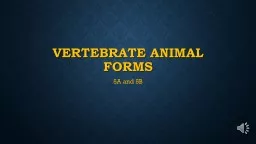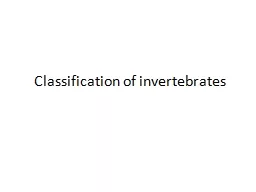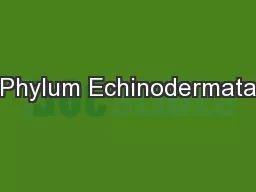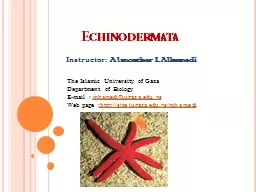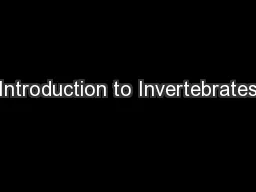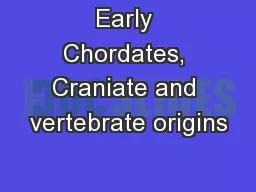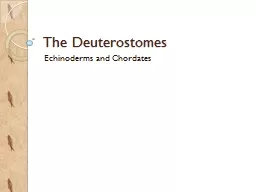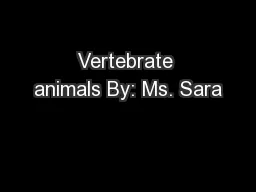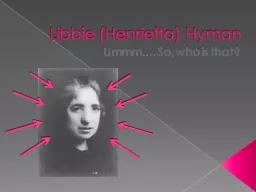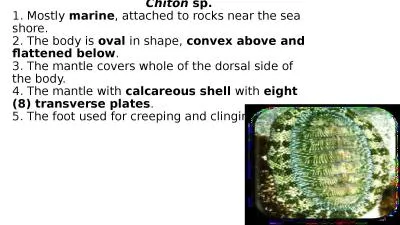PPT-Invertebrates II: Mollusca, Arthropoda, Echinodermata, Chordata (non-vertebrate chordates)
Author : myesha-ticknor | Published Date : 2018-12-17
More species 200000 than any other animal phylum except Arthropoda Soft body often protected by CaCO 3 shell Unsegmented typically bilaterally symmetrical I Phylum
Presentation Embed Code
Download Presentation
Download Presentation The PPT/PDF document "Invertebrates II: Mollusca, Arthropoda, ..." is the property of its rightful owner. Permission is granted to download and print the materials on this website for personal, non-commercial use only, and to display it on your personal computer provided you do not modify the materials and that you retain all copyright notices contained in the materials. By downloading content from our website, you accept the terms of this agreement.
Invertebrates II: Mollusca, Arthropoda, Echinodermata, Chordata (non-vertebrate chordates): Transcript
More species 200000 than any other animal phylum except Arthropoda Soft body often protected by CaCO 3 shell Unsegmented typically bilaterally symmetrical I Phylum Mollusca 2004 Amanda Demopoulos. Review. At first, limit your learning to the features that are . unique. to a group and/or groups that “. invented. ” features or had “. firsts. .”. Use the characteristics given to name the group.. Kingdom Animalia. Phylum Echinodermata. Class Asteroidea. Class Ophiuroidea. Class Echinoidea. Class Holothuroidea. Echinoderms:. Name means “spiny skin” . Sea stars, sea cucumbers, sea urchins, etc.. When Carl Linnaeus first created his method for organizing animals, he had just two families of invertebrates:. . Insecta. (insects) and . Vermes. (worms).. Since that time, scientists have found more invertebrates and have created more classifications. We will talk about six main categories or families of invertebrates.. 5A and 5B. Use of animals in research. Patterned after Federal regulations for use of animals in research. Consider the following points. Replace vertebrate animals where possible with invertebrate animals. Q. What are invertebrates? Give examples.. A: Animals without backbones are called invertebrates. Ex jellyfish, spider and crabs don’t have back bones.. Q . How many kind of invertebrates are there on the earth?. (Means spiny skin). https://vimeo.com/37295088. Echinodermata. Classes. Sea stars. Asteriodea(Stelleroids). Aka starfish. Echinodermata. Classes. Crinoidea/Crinoids. Feather stars. Sea lilies. Echinodermata. Almonther. I. . Alhamedi. The Islamic University of Gaza. Department . of . Biology. E-mail : . mhamedi@iugaza.edu.ps. Web page :. http. ://site.iugaza.edu.ps/mhamedi. Characteristics of . Phylum Echinodermata. Laboratory 27 & 28. Introduction to Invertebrates. An . invertebrate. is an animal without a backbone. . The group includes 95% of all animal species. Introduction to Invertebrates. There is no escaping the invertebrates!. Where does it start?. Part 1. Phylum Chordata. Animal Kingdom. Vertebrates over here. Chordata (animals with notochord at some stage in life cycle). Craniata (euchordates with a cranium) = Vertebrata. Developmental Variations. During embryonic development, the process of . gastrulation. forms the digestive cavity.. Gastrulation. varies in the animal kingdom. No . gastrulation. (. placozoans. ). Characteristics . of . vertebrate . animals. Animals with a backbone or vertebral column.. There are 5 major subgroups of vertebrate animals.. Vertebrate animals: Mammals. Rabbit. Vertebrate animals: Fish. Ummm. …. So, who is that?. BIOGRAPHY. Born December 6. th,. 1888. Died August 3. rd,. 1969 (after the Hippies). Received a B.A. in 1910. Ph.D. in 1915. Research assistant to Prof. Charles Manning Child. Topic: Invertebrates Definition and Characteristics. B.Ed. (. Hons. ) Secondary. Semester IV. Subject: Biology IV(minor). Course Title: Invertebrates Diversity. Represented By: Ms Sidra . Younis. Department of Education(Planning and Development). : . Polyplacophora. . Chiton . sp. . 1. Mostly . marine. , attached to rocks near the sea shore. . 2. The body is . oval . in shape, . convex above and flattened below.
Download Document
Here is the link to download the presentation.
"Invertebrates II: Mollusca, Arthropoda, Echinodermata, Chordata (non-vertebrate chordates)"The content belongs to its owner. You may download and print it for personal use, without modification, and keep all copyright notices. By downloading, you agree to these terms.
Related Documents

